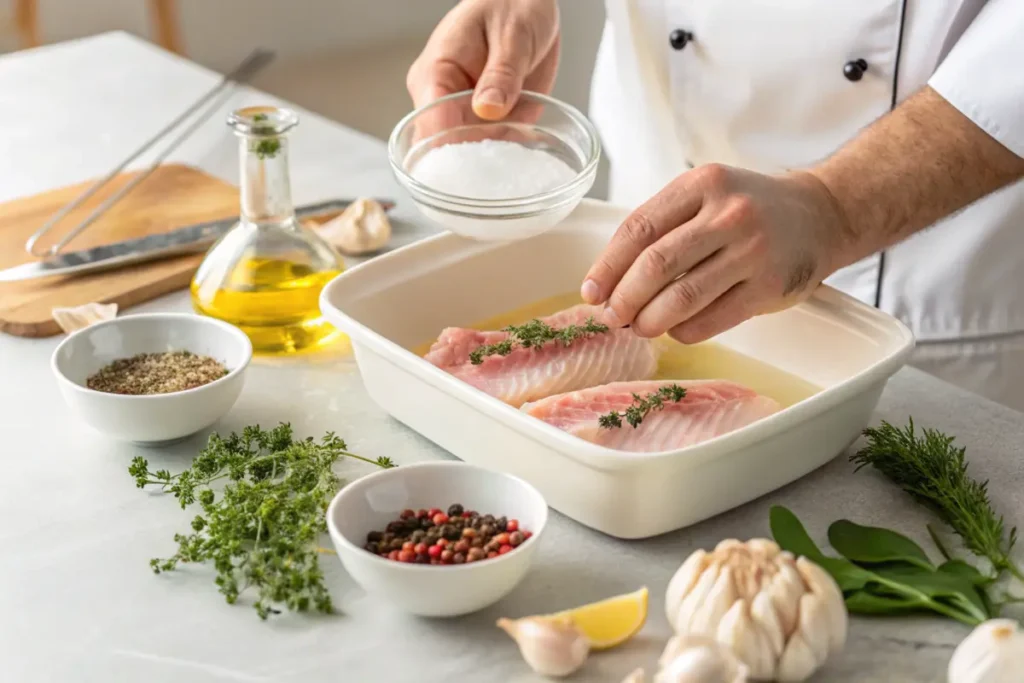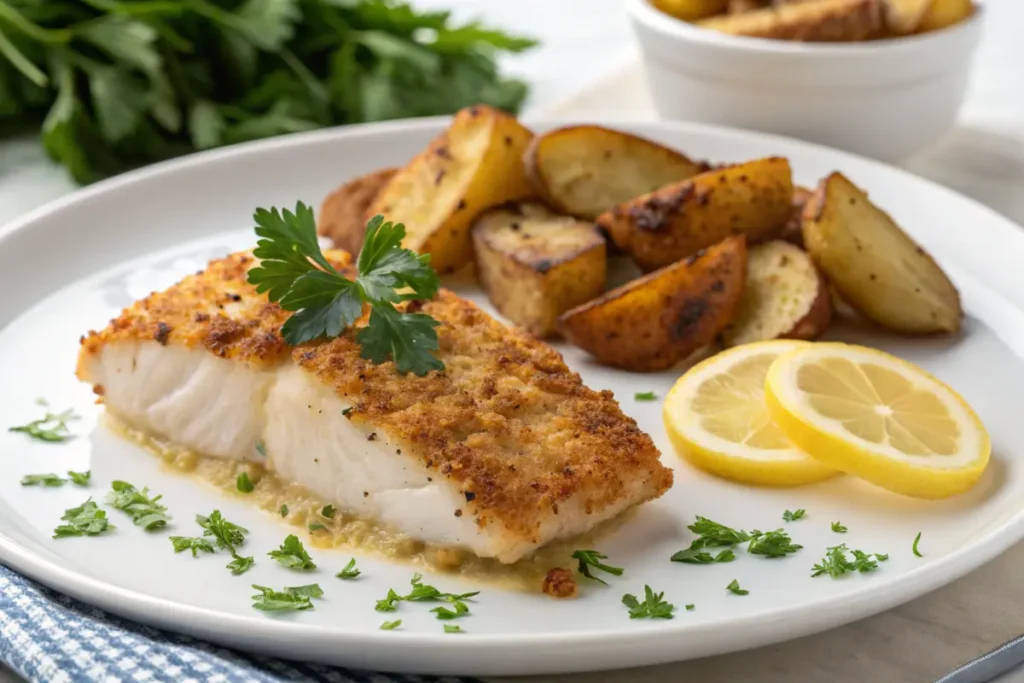Rockfish is a delightful, versatile seafood loved for its flaky texture and mild flavor. Yet, like many kinds of fish, its preparation can make or break the dish. A common question arises: Should I soak rockfish before cooking? This article delves into the reasons, methods, and best practices for soaking rockfish to help you create a memorable meal. Along the way, we’ll explore when to skip soaking, how to cook soaked rockfish, and even debunk some myths. Let’s dive in!
Understanding the Characteristics of Rockfish
What Is Rockfish?
Rockfish is a term for various species of fish found along the Pacific Coast. These fish boast firm, white flesh that’s ideal for a range of cooking methods, from frying to steaming. Their mild taste makes them a favorite for fish and chips, while their flaky texture pairs beautifully with seasonings and marinades.
Rockfish are often caught fresh, but they may still carry a subtle “fishy” odor due to their natural oils. This is where soaking becomes a popular preparation step for enhancing flavor and texture.
Nutritional Benefits of Rockfish
Beyond its culinary versatility, rockfish is a nutritional powerhouse. A single serving is packed with lean protein, omega-3 fatty acids, and essential vitamins like B12 and D. These nutrients support heart health, brain function, and overall well-being. It’s also low in calories, making it a great choice for health-conscious eaters.
For seafood lovers seeking a balanced diet, rockfish delivers a satisfying meal without the guilt. Understanding these nutritional perks highlights why proper preparation—including soaking—can maximize its potential on the plate.
Reasons to Soak Rockfish Before Cooking
Eliminating Fishy Odor and Flavor
Have you ever opened a package of fish and noticed a strong, lingering smell? This odor often stems from compounds in the fish’s natural oils. Soaking rockfish, especially in milk or a similar solution, can neutralize these compounds, significantly reducing the “fishy” aroma. The soaking process allows the proteins in the milk to bind with the fish oils, making them easier to rinse away. When asking, “Should I soak rockfish before cooking?” the answer often hinges on whether you want a cleaner, milder flavor.
By eliminating unwanted odors, soaking enhances the overall taste of the fish, creating a blank canvas for spices and marinades to shine. This step is particularly helpful when cooking for guests who might be sensitive to fishy flavors.
Improving Texture and Taste
Soaking rockfish doesn’t just affect flavor—it also improves texture. The soaking process, whether in milk, brine, or another liquid, softens the fish and makes it more tender. This is especially important for rockfish recipes requiring frying, grilling, or baking, as a tender texture ensures even cooking and a melt-in-your-mouth bite.
Additionally, some soaking liquids, like brines, enhance the fish’s natural flavors by infusing it with mild seasoning. This extra layer of taste can elevate simple recipes, turning them into showstoppers. For example, a saltwater soak slightly firms up the meat, giving it a delightful bite once cooked.
Soaking Methods for Rockfish
Using Milk or Buttermilk
One of the most popular methods for soaking rockfish involves milk or buttermilk. The enzymes in these liquids break down proteins and mitigate any unpleasant odors. To use this method:
- Place your rockfish fillets in a shallow dish.
- Cover them with milk or buttermilk, ensuring they’re fully submerged.
- Let the fish soak for 20–30 minutes.
This simple technique is effective for neutralizing odors and creating a creamy, mild flavor profile.
Saltwater Brine

A saltwater brine is another excellent option, particularly for those looking to enhance the fish’s natural flavor. To prepare a brine:
- Dissolve ¼ cup of salt in 4 cups of water.
- Add optional seasonings like garlic, lemon, or herbs.
- Submerge the fillets and let them soak for up to an hour.
The salt works to firm the fish while seasoning it lightly. This method is ideal if you’re planning to grill or bake the rockfish, as the subtle brine amplifies its natural taste.
Alternative Soaking Liquids
For those feeling adventurous, other liquids like lemon water, vinegar, or light marinades can be used. Lemon water, for instance, adds a tangy brightness, while a vinegar soak can be useful for recipes requiring acidic balance. Always remember not to overdo the soaking time, as excessive acid can start cooking the fish, altering its texture.
Pro Tip: If you’re curious about more creative rockfish recipes, check out this guide to preparing rockfish. It’s packed with tips and techniques to level up your cooking game.
When Not to Soak Rockfish
Preserving the Natural Flavor
Sometimes, less is more. If you’re planning to showcase the natural taste of fresh rockfish, skipping the soak might be the better choice. Should I soak rockfish before cooking? Not always! High-quality rockfish, especially when freshly caught, boasts a mild flavor that doesn’t necessarily need masking or enhancement. Cooking methods like grilling or steaming allow the fish’s natural sweetness to take center stage.
Additionally, some recipes, such as ceviche or sashimi, rely on the raw, unaltered taste of the fish. In these cases, soaking can dilute the delicate flavors that make the dish unique.
Quick-Cooking Techniques That Skip Soaking
In scenarios where time is short, skipping the soak can save you precious minutes without compromising too much on taste. Techniques like pan-searing or stir-frying are perfect for unsoaked rockfish because the high heat seals in its moisture and flavor. Just be sure to pat the fillets dry before cooking to achieve a beautiful golden crust.
For more quick seafood ideas, consider checking out our guide on rockfish recipes and techniques, where you’ll find tips tailored for fast, flavorful meals.
Cooking Techniques for Soaked Rockfish
Baking and Frying

Soaking rockfish before baking or frying enhances its ability to hold seasonings and maintain moisture. For baked dishes, marinated or brined fish produces tender, flavorful results. Simply pat the fish dry after soaking, season with your favorite herbs, and bake at 375°F for about 15–20 minutes.
For frying, soaked rockfish pairs perfectly with crispy coatings like panko or cornmeal. The moisture from soaking helps the batter adhere better, creating an irresistible crunch. Try a Cajun-seasoned cornmeal crust for a southern twist.
Steaming and Poaching
Soaked rockfish shines when steamed or poached. These gentle cooking methods preserve the fish’s delicate texture while locking in moisture. Add aromatics like ginger, garlic, or fresh dill to the cooking liquid for an elevated flavor profile. For poaching, opt for a broth or wine-infused liquid to complement the fish’s mild taste.
Pairing Soaked Rockfish with Sides
To complete your meal, choose sides that balance the flavors of your soaked rockfish. Steamed vegetables, roasted potatoes, or a zesty slaw make excellent accompaniments. For an adventurous pairing, try a creamy lemon dill sauce or garlic aioli for dipping.
Pro Tip: If you’re inspired by these cooking methods, be sure to explore more versatile rockfish ideas in our collection of best rockfish recipes. Whether baked, fried, or steamed, rockfish can transform into a masterpiece on your plate!
Common Mistakes When Preparing Rockfish
Overlooking the Soaking Process
A frequent mistake is neglecting to ask, Should I soak rockfish before cooking? While soaking isn’t always necessary, it can dramatically improve the texture and flavor for certain recipes. Skipping this step might result in a fishy odor or less flavorful dish, especially if the fish isn’t freshly caught. A quick soak in milk or brine often resolves these issues and creates a better foundation for seasoning.
Over-Soaking the Fish
On the flip side, over-soaking rockfish can lead to undesirable outcomes. Leaving the fish in an acidic or salty liquid for too long can cause the meat to break down, making it mushy. To avoid this, follow recommended soaking times—typically 30 minutes for milk or buttermilk and up to an hour for brine.
Neglecting Proper Drying Techniques
Even after soaking, failing to pat the fillets dry can affect the cooking process. Moisture on the surface prevents the formation of a crisp crust when frying or searing. A quick pat with paper towels ensures your fish cooks evenly and develops the perfect texture.
Final Thoughts and FAQs
Key Takeaways on Soaking Rockfish
The decision to soak rockfish ultimately depends on your recipe and personal preferences. Soaking can neutralize strong odors, improve texture, and infuse subtle flavors. Whether you’re baking, frying, or steaming, starting with properly prepared fish elevates the final dish. So, next time you’re prepping dinner, consider asking yourself: Should I soak rockfish before cooking?
For those new to this technique, experimenting with different soaking methods like milk or brine can unlock new flavors and textures. By avoiding common mistakes and tailoring your approach to the recipe, you’ll master the art of cooking rockfish in no time.
FAQs
1. Why should I soak fish in milk before cooking?
Milk neutralizes fishy odors by binding to the oils responsible for the smell, resulting in a cleaner and milder flavor.
2. How long should I soak rockfish in brine?
The ideal time is 30 minutes to an hour. Over-soaking can make the fish too salty or affect its texture.
3. Does soaking rockfish before cooking remove nutrients?
No, the soaking process has minimal impact on the fish’s nutritional value when done correctly.
4. What’s the best method for soaking rockfish?
Milk or buttermilk works best for reducing odors and enhancing flavor, while brine is ideal for seasoning and firming the texture.
With these tips in mind, you’re ready to make rockfish the star of your next meal! For more helpful cooking advice, explore our complete guide to seafood preparation.
Pairing Rockfish with Sauces and Seasonings
Classic Sauces for Rockfish
When preparing a delicious meal, the right sauce can transform your dish. Rockfish, with its mild and flaky texture, pairs beautifully with creamy and citrus-based sauces. A lemon-dill cream sauce, for example, enhances the natural flavors of the fish without overpowering it. For those who enjoy a bit of heat, a tangy sriracha mayo can provide a delightful kick.
One of the most common questions, Should I soak rockfish before cooking?, also plays into sauce pairing. Soaked rockfish tends to absorb flavors more readily, making it a perfect candidate for bold, complementary sauces like garlic butter or herb pesto.
Creative Seasoning Ideas
Seasonings are another way to bring out the best in rockfish. For a simple yet flavorful option, try a blend of smoked paprika, garlic powder, and sea salt. Want to explore global flavors? Experiment with cajun spices for a southern twist or turmeric and cumin for a warm, earthy profile.
Soaking can also enhance the impact of seasonings. For instance, a light brine prepares the fish to absorb dry rubs more effectively. Always season generously, as rockfish’s subtle taste thrives on well-balanced spices.
Enhancing Your Rockfish Cooking Skills
Experimenting with New Techniques
Cooking rockfish is as versatile as it is satisfying. If you’ve mastered frying and baking, why not try grilling or sous vide? Grilling gives the fish a smoky flavor and a delightful char, while sous vide ensures perfectly cooked, tender fillets every time. Asking Should I soak rockfish before cooking? is particularly important when trying these methods, as pre-soaking ensures the fish stays juicy and flavorful.
If you’re baking, consider wrapping the fish in parchment paper with fresh herbs and a splash of white wine. This technique, known as “en papillote,” locks in moisture and infuses the fish with aromatics.
Tips for Perfecting Your Rockfish Dishes
- Start Fresh: Whenever possible, use fresh rockfish for the best flavor and texture.
- Don’t Overcook: Rockfish cooks quickly, so keep an eye on it to avoid drying it out.
- Use Quality Ingredients: From seasonings to sauces, using high-quality ingredients elevates the dish.
For more inspiration, explore our collection of creative rockfish recipes. Whether you’re a seasoned chef or just starting out, these ideas will help you take your seafood game to the next level.
Conclusion: Mastering Rockfish Preparation
Rockfish is a versatile, delicious seafood that can be the star of countless dishes when prepared thoughtfully. From soaking to seasoning, each step plays a vital role in bringing out its best flavors and textures. So, should I soak rockfish before cooking? The answer depends on your recipe and preferences, but soaking can significantly enhance the fish’s taste and tenderness, especially if it needs odor-neutralizing or flavor-infusing preparation.
Whether you’re baking, frying, grilling, or steaming, experimenting with soaking methods like milk, brine, or marinades can elevate your cooking. Pair your perfectly cooked rockfish with complementary sauces and sides for a meal that’s sure to impress.
By avoiding common pitfalls, such as over-soaking or neglecting to dry the fish, you’ll refine your skills and consistently achieve fantastic results. Rockfish is not just a fish; it’s an opportunity to explore creativity in the kitchen while delivering healthy, satisfying meals.
Dive into the world of rockfish and embrace the many ways to make it your own. With the tips and techniques outlined here, you’re well on your way to becoming a rockfish expert!
